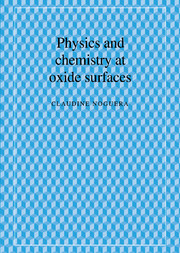3 - Electronic structure of surfaces
Published online by Cambridge University Press: 24 September 2009
Summary
In the surface layers, the breaking of anion–cation bonds and the modifications of inter-atomic distances, induced by relaxation, rumpling or reconstruction effects, perturb the electrostatic potentials and the orbital hybridization. The surface electronic structure is thus modified and presents specific features compared to the bulk characteristics. In this chapter, we will discuss various aspects of these changes, relevant for planar semi-infinite systems, thin films and defected surfaces. We will restrict ourselves to the results obtained on single crystals, prepared under controlled conditions and studied in ultra-high vacuum (Henrich, 1983; 1985; Henrich and Cox, 1994). Instead of focusing on specific properties of this or that oxide, we will try to extract the general trends concerning the density of states, the gap width, the charge densities, etc., and, whenever this is possible, we will point out the physical origin of the differences found between the bulk and the surface electronic structure.
Experimental and theoretical studies
The study of the surface electronic structure requires specific tools. For example, in spectroscopic experiments, in order to enhance the surface signal with respect to the bulk one, to obtain information on the outer layers, one has to send or detect particles with small mean free paths, which mainly sample the few outer layers. Similarly, special care has to be taken in the numerical approaches. We will quickly review some aspects of this question, both from the experimental and the theoretical sides.
- Type
- Chapter
- Information
- Physics and Chemistry at Oxide Surfaces , pp. 68 - 105Publisher: Cambridge University PressPrint publication year: 1996

